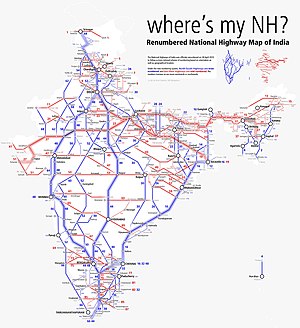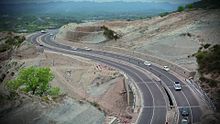
A | B | C | D | E | F | G | H | CH | I | J | K | L | M | N | O | P | Q | R | S | T | U | V | W | X | Y | Z | 0 | 1 | 2 | 3 | 4 | 5 | 6 | 7 | 8 | 9

The national highways in India are a network of trunk roads owned by the Ministry of Road Transport and Highways. National highways have flyover access or some controlled-access, where entrance and exit is through the side of the flyover. At each highway intersection, flyovers are provided to bypass the traffic on the city, town, or village. These highways are designed for speeds of 100 km/h. Some national highways have interchanges in between, but do not have total controlled-access throughout the highways. The highways are constructed and managed by the Central Public Works Department (CPWD), the National Highways and Infrastructure Development Corporation Limited (NHIDCL), and the public works departments (PWD) of state governments. Currently, the longest national highway in India is National Highway 44 at 4,112 km (2,555 mi). India started four laning of major national highways with the National Highway Development Project (NHDP). As of March 2022 India have approximately 35,000 km of four laned National highways.
The National Highways Authority of India (NHAI) and the National Highways and Infrastructure Development Corporation Limited (NHIDCL) are the nodal agencies responsible for building, upgrading, and maintaining most of the National Highways network. It operates under the Ministry of Road Transport and Highways. The National Highways Development Project (NHDP) is a major effort to expand and upgrade the network of highways. NHAI often uses a public–private partnership model for highway maintenance, and toll-collection. NHIDCL uses Engineering Procurement and Construction (EPC) model to build, develop and maintain strategic roads in international borders of the country.
In India, National Highways are at-grade roads, whereas Expressways are controlled-access highways where entrance and exit is controlled by the use ramps that are incorporated into the design of the expressway. National Highways follows standards set by Indian Roads Congress and Bureau of Indian Standards.
Characteristics




India has 161,350 km (100,260 mi) of national highways as of March 2022 compared to 1,01,011 km in FY 2013–14.[1][2][3] According to Union road transport and highways minister Nitin Gadkari on Tuesday said total length of the national highways in the country increased by about 59% in the last nine years.[1]
National highways constituted 2.7% of India's total road network, but carried about 40% of road traffic, as of 2013.[4] In 2016, the government vowed to double the highway length from 1,01,011 to 2,00,000 km.[5]
The majority of existing highways are now four-lane roads (two lanes in each direction), though much of this is being expanded to six or more lanes. Some sections of the network are toll roads. Only a few highways are built with concrete. Bypasses have been constructed around larger towns and cities to provide uninterrupted passage for highway traffic. Some existing roads have been reclassified as national highways.
History
The National Highways Act, 1956[6] provided for public i.e. state investment in the building and maintenance of the highways.
The National Highways Authority of India was established by the National Highways Authority of India Act, 1988. Section 16(1) of the Act states that the function of NHAI is to develop, maintain, and manage the National Highways and any other highways vested in, or entrusted to, it by the Government of India.
In 1998 India launched a massive program of highway upgrades, called the National Highways Development Project (NHDP), in which the main north–south and east–west corridors and highways connecting the four metropolitan cities (Delhi, Mumbai, Chennai and Kolkata) have been fully paved and widened into four-lane highways. Some of the busier National Highway sectors in India were also converted to four- or six-lane limited-access highways.
National Highways and Infrastructure Development Corporation Limited started functioning as of 18 July 2014.[7] It is a fully owned company of Government of India under Ministry of Road Transport and Highways and was created to develop, maintain and manage the national highways, strategic roads and other infrastructure of India. It was dedicated to the task of promoting regional connectivity in parts of the country which share international boundaries. It is responsible for the development, maintenance and management of National Highways in hilly terrain of North-East part of India, Andaman & Nicobar Islands, Himachal Pradesh, Jammu & Kashmir, Ladakh and Uttarakhand. It works as a specialised agency in high altitude areas and border areas. Apart from highways, NHIDCL is constructing logictic hubs and transport related infrastructure e.g. multimodal transport hubs such as bus ports, container depots, automated multilevel car parking etc.
The Ministry of Road Transport and Highways adopted a new systematic numbering of National Highways in April 2010.[8] It is a systematic numbering scheme based on the orientation and the geographic location of the highway. The new system indicates the direction of National Highways whether they are east–west (odd numbers) or north–south (even numbers). It also indicates the geographical region where they are with even numbers increasing from east to west starting from NH2 and odd numbers increasing from north to south starting from NH1.[9]
Bharatmala, a centrally-sponsored and funded road and highways project of the Government of India[10] with a target of constructing 83,677 km (51,994 mi)[11] of new highways, was started in 2018. Phase I of the Bharatmala project involves the construction of 34,800 km of highways (including the remaining projects under NHDP) at an estimated cost of ₹5.35 lakh crore (US$67 billion) by 2021–22.[12]
Network length
| Year | Total length in km |
|---|---|
| 2022-2023 | 145,240
|
| 2021 - 2022 | 140,995
|
| 2020 - 2021 | 136,440
|
| 2019 - 2020 | 132,995
|
| 2018 - 2019 | 132,500
|
| 2017 - 2018 | 126,500
|
| 2016 - 2017 | 114,158
|
| 2015 - 2016 | 101,011
|
| 2014 - 2015 | 97,991
|
| 2013 - 2014 | 91,287
|
| 2012 - 2013 | 79,116
|
| 2011 - 2012 | 76,818
|
| 2010 - 2011 | 70,934
|
| 2009 - 2010 | 70,934
|
| 2008 - 2009 | 70,548
|
| 2007 - 2008 | 66,754
|
| 2006 - 2007 | 66,590
|
| 2005 - 2006 | 66,590
|
| 2004 - 2005 | 65,569
|
| 2003 - 2004 | 65,569
|
| 2002 - 2003 | 58,112
|
| 2001 - 2002 | 58,112
|
| 1991 - 2001 | 57,737
|
| 1981 - 1991 | 33,650
|
| 1971 - 1981 | 31,671
|
| 1961 - 1971 | 23,838
|
| 1950 - 1961 | 23,798
|
| State / union territory | State PWD | NHAI | NHIDCL[17] | Total length as on 31.03.2019 (km) |
|---|---|---|---|---|
| Andaman and Nicobar Islands | 87 | 331 | ||
| Andhra Pradesh | 6,912 | |||
| Arunachal Pradesh | 1,035 | 2,537 | ||
| Assam | 1,010 | 3,909 | ||
| Bihar | 5,358 | |||
| Chandigarh | 15 | |||
| Chhattisgarh | 3,605 | |||
| Dadra and Nagar Haveli | 31 | |||
| Daman and Diu | 22 | |||
| Delhi | 157 | |||
| Goa | 293 | |||
| Gujarat | 6,635 | |||
| Haryana | 3,166 | |||
| Himachal Pradesh | 320 | 2,607 | ||
| Jammu & Kashmir | 436 | 2,423 | ||
| Jharkhand | 3,367 | |||
| Karnataka | 7,335 | |||
| Kerala | 1,782 | |||
| Lakshadweep | 0 | |||
| Madhya Pradesh | 8,772 | |||
| Maharashtra | 17,757 | |||
| Manipur | 1,751 | 1,750 | ||
| Meghalaya | 823 | 1,156 | ||
| Mizoram | 372 | 1422.5 | ||
| Nagaland | 324 | 1,548 | ||
| Odisha | 5,762 | |||
| Puducherry | 27 | |||
| Punjab | 3,274 | |||
| Rajasthan | 10,342 | |||
| Sikkim | 595 | 463 | ||
| Tamil Nadu | 6,742 | |||
| Telangana | 3,795 | |||
| Tripura | 573 | 854 | ||
| Uttarakhand | 660 | 2,949 | ||
| Uttar Pradesh | 11,737 | |||
| West Bengal | 4 | 3,664 | ||
| India total | 48,590[18] | 7,990 | 132,500[19] |
Year wise national highways in India, by state and union territory
As at end-March and length in kms.
Source: Ministry of Road Transport and Highways, Government of India.[20]
| State/union territory | 2005 | 2006 | 2007 | 2008 | 2009 | 2010 | 2011 | 2012 | 2013 | 2014 |
|---|---|---|---|---|---|---|---|---|---|---|
| Andaman and Nicobar Islands | 300 | 300 | 300 | 300 | 300 | 300 | 300 | 300 | 300 | 300 |
| Andhra Pradesh | 4472 | 4472 | 4472 | 4472 | 4537 | 4537 | 4537 | 4537 | 5022 | 6590 |
| Arunachal Pradesh | 392 | 392 | 392 | 392 | 1992 | 1992 | 1992 | 2027 | 2027 | 2027 |
| Assam | 2836 | 2836 | 2836 | 2836 | 2836 | 2836 | 2836 | 2940 | 2940 | 3634 |
| Bihar | 3537 | 3642 | 3642 | 3642 | 3642 | 3642 | 3642 | 4106 | 4168 | 4467 |
| Chandigarh | 24 | 24 | 24 | 24 | 24 | 24 | 24 | 24 | 24 | 24 |
| Chhattisgarh | 2184 | 2184 | 2184 | 2184 | 2184 | 2184 | 2184 | 2289 | 2289 | 3031 |
| Delhi | 72 | 72 | 72 | 72 | 72 | 80 | 80 | 80 | 80 | 80 |
| Goa | Zdroj:https://en.wikipedia.org?pojem=National_Highway_(India)

